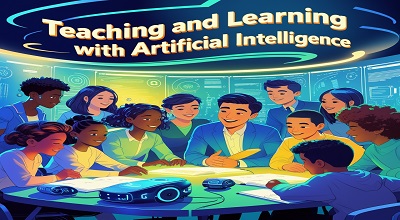Teaching and Learning with Artificial Intelligence
Teaching and Learning with Artificial Intelligence: Artificial Intelligence (AI) has revolutionized various industries, and education is no exception. AI-powered tools are transforming traditional teaching and learning methods, making education more personalized, efficient, and accessible. From intelligent tutoring systems to automated grading, AI is reshaping how educators teach and how students learn.
This article explores the latest advancements in AI for education, providing real-world examples, benefits, challenges, and future trends.
The Role of AI in Modern Education
AI in education serves multiple purposes, including:
- Personalized Learning: AI adapts to individual student needs, providing customized lessons.
- Automation of Administrative Tasks: AI helps with grading, scheduling, and student assessments.
- Enhanced Engagement: AI-driven gamification and interactive tools make learning more engaging.
- Accessibility: AI supports students with disabilities through speech recognition and text-to-speech tools.
How AI Enhances Teaching?
Automated Grading and Feedback
AI tools like Gradescope and Turnitin help teachers grade assignments quickly while providing instant feedback.
Intelligent Tutoring Systems
Platforms like Squirrel AI and Carnegie Learning offer one-on-one tutoring, adapting to students’ learning paces.
AI-Powered Lesson Planning
Tools like Education Copilot and MagicSchool AI generate lesson plans, quizzes, and presentations in seconds.
Virtual Teaching Assistants
AI chatbots like Jill Watson (Georgia Tech) answer student queries, reducing teachers’ workload.
How AI Enhances Learning?
Adaptive Learning Platforms
- Knewton Alta: Adjusts content difficulty based on student performance.
- DreamBox: Provides personalized math lessons for K-8 students.
AI-Powered Language Learning
- Duolingo: Uses AI to tailor language exercises.
- ELSA Speak: Helps improve pronunciation with real-time feedback.
Virtual and Augmented Reality (VR/AR) in Education
- Google Expeditions: Offers immersive virtual field trips.
- Labster: Provides virtual science lab simulations.
AI for Special Education
- Microsoft Immersive Reader: Assists dyslexic students with text decoding.
- Otter.ai: Transcribes lectures for hearing-impaired students.
Examples of AI in Education
ChatGPT in Classrooms
- Helps students with homework, essay writing, and research.
- Teachers use it to generate quiz questions and discussion prompts.
IBM Watson Education
- Analyzes student data to predict learning gaps.
- Recommends tailored resources for improvement.
Coursera’s AI-Powered Recommendations
- Suggests courses based on learners’ interests and past behavior.
ScribeSense
- Uses AI to analyze handwriting and provide feedback on penmanship.
Content Technologies, Inc. (CTI)
- Generates customized textbooks based on curriculum needs.
Challenges and Ethical Considerations
Data Privacy Concerns
- AI collects student data, raising concerns about misuse.
- Compliance with GDPR and FERPA is essential.
Bias in AI Algorithms
- AI may reflect biases in training data, affecting fairness.
- Requires continuous monitoring and ethical AI development.
Over-Reliance on AI
- Risk of reducing human interaction in education.
- Teachers must balance AI use with traditional methods.
Future of AI in Education
- AI-Powered Lifelong Learning: Continuous upskilling through AI-driven platforms.
- Emotion AI: Detects student emotions to improve engagement.
- Blockchain for Credentials: Secure, AI-verified digital diplomas.
- AI in Global Education: Bridging gaps in underprivileged regions.
Conclusion
AI is transforming education by making learning more personalized, efficient, and accessible. While challenges like data privacy and bias exist, the benefits outweigh the risks. Educators and institutions must embrace AI responsibly to unlock its full potential.
FAQs
Q1: How does AI personalize learning?
AI analyzes student performance and adjusts content difficulty, pacing, and teaching methods to suit individual needs.
Q2: Can AI replace teachers?
No, AI is a tool to assist teachers, not replace them. Human interaction remains crucial in education.
Q3: What are the best AI tools for teachers?
Popular tools include Gradescope, MagicSchool AI, ChatGPT, and Carnegie Learning.
Q4: Is AI in education expensive?
While some AI tools require investment, many free or low-cost options (like Duolingo and Khan Academy) are available.
Q5: How can schools ensure ethical AI use?
By implementing strict data privacy policies, auditing AI for bias, and training educators on responsible AI integration.
Free Link: Light x Shadow APK
